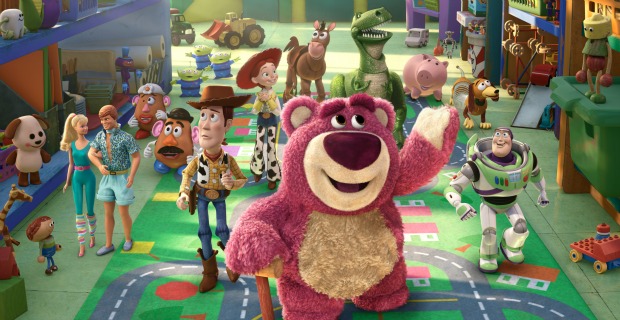Toy Story 3
The Toy Story series has been unusual in its consistently high level of quality, and when the box-set comes out it deserves to earn pride of place in any family film library.
Plot summary
The toys are mistakenly delivered to a day-care centre instead of the attic right before Andy leaves for college, and it's up to Woody to convince the other toys that they weren't abandoned and to return home.

It’s hard to believe, but it has been eleven years since we last saw Woody, Buzz and their assorted friends on our screens; though the intervening period may have seen the audience of 1999 grow up and become adults, the band of toys remain essentially the same. Their once devoted owner Andy, however, is leaving home for college. A new dilemma faces the toys: where will they go once he has left? In the bin? In the attic? Or to new children?
They end up in day-care, a seemingly wondrous destination filled with friendly toys and the promise of being played with eternally by loving children. Avuncular teddy Lots ‘o Huggin’ Bear (Ned Beatty) welcomes Andy’s toys with open, cuddly arms – but things are not quite as they seem. After all, toddlers go to day-care, and as any babysitter can tell you, toddlers are essentially dribbling, violent psychopaths. As ever with a Toy Story film, each part of the story is crammed with humour, and the occasionally serious prison break theme that emerges is always leavened with great gags and witty characterisation. Amongst the new faces, the best is doubtlessly Ken, Barbie’s new romantic lead (voiced by Michael Keaton). Your younger self may have unconsciously intuited that Ken may not have shared Action Man’s rugged temperament; and your younger self was bang on. Ken is fabulous, and so is his disco-themed closet (which is where, he informs us, “the magic happens!”). The use of camp humour as a way to make the children giggle and the adults exchange knowing nods is well judged, and reconfirms the widely held opinion that Pixar do this type of thing far better than their animation house rivals, who shall remain nameless…
Much has been made of Toy Story 3’s affecting end third. “It makes grown men cry!” has been the main comment, but whilst this may have some instances of being true, don’t go in expecting anything too devastating – according to the filmmakers, they never aimed to get the audience’s tears rolling. Still, what happens is sad and sweet, and written with the kind of restraint not seen in more cynical weepies. Children are probably not going to care much about this emotional catharsis, but my guess is that any adults yearning for lost youth may well up a little.
Toy Story 3 is an even continuation of its predecessors, in terms of script, storyline and comedy value. There is only one change worth noting: it can now be seen in 3D. The effects of this visual advance are kept subtle so as not to distract from the story, and make no major difference to how one sees it in a cinema. The spatial depth did create a sense of immediacy, but it wasn’t imperative to the film overall. In fact, the 3D lenses used are pretty uncomfortable; wearing them was for me the only drawback to the experience.
Way back in 1995, the Pixar team did a clever thing by animating a bunch of toys; they invented a new way of approaching the themes of childhood – the fears of abandonment; growing up; the love of play, and of adventure – and made it universally appealing. The Toy Story series has been unusual in its consistently high level of quality, and when the boxset comes out it deserves to earn pride of place in any family film library.










COMMENTS